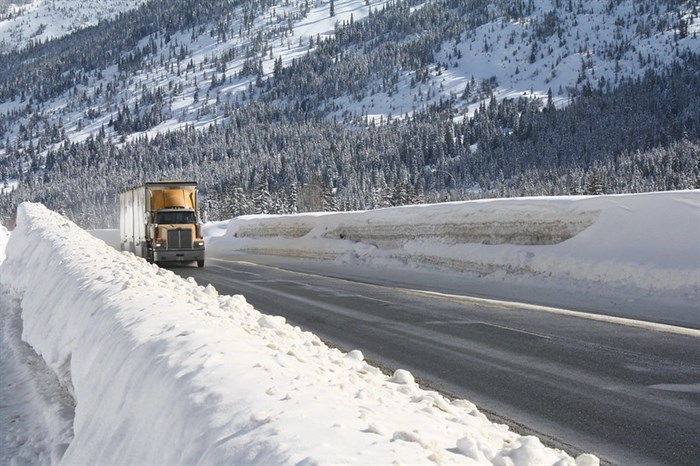
FILE PHOTO
Image Credit: Province of B.C.
January 13, 2022 - 7:00 AM
It’s not just bad drivers of commercial trucks we should be worried about. It’s the trucks themselves.
Back in December, YWC Transport, based in the Lower Mainland, had its 171 trucks pulled off the road after a video was taken of one of their drivers passing another truck on a solid double line on Highway 5A between Princeton and the Okanagan Connector.
READ MORE: iN VIDEO: Dangerous driving on B.C. highway lands national trucking company in hot water
That suspension was done by the B.C. Ministry of Transportation’s Commercial Vehicle Safety and Enforcement branch. The company still cannot operate as the audit is ongoing.
“There were some other flags there with this particular carrier when they (inspectors) were looking at its safety rating coming from the audit,” Richard Roberts, deputy director of the branch, told iNFOnews.ca. “We do have the ability to suspend carriers during an investigation. That’s done under serious conditions.”
He couldn’t comment further on this investigation or when it might conclude but did say that each carrier has its own safety rating.
Right now, those ratings aren’t available to the public but the branch is working on changing that, as some jurisdictions have already done, Roberts said.
The Commercial Vehicle Safety and Enforcement branch has been evolving over the past few years from one that focused primarily on vehicle inspections at weigh scales to an active agency that, similar to the police, enforces traffic rules such as speeding, passing on double lines or running stop signs.
Weight violations are still common enough to justify the weigh scales operating – and truckers are fined based on weight – but inspectors are spending more time out on the roads doing random checks or enforcing traffic rules.
Still, safety inspections are a big part of what the branch does, and with good reason.
Out of the thousands of inspections it does each year, the branch finds somewhere in the low to mid-20% range of trucks meet its “out-of-service” criteria.
“Any time that our officers do an inspection and they find an out-of-service item – that could be as minor as maybe a rear signal light out and it goes up from there in terms of severity of what we find – they’re out of service until that gets fixed,” Roberts said. “In some cases, depending on what the defect is or potentially how many of them there are, we will just have the vehicle towed from the scene because it poses a significant safety risk.”
There are two areas that stand out.
“Generally speaking, what we find and what’s pretty consistent across most jurisdictions, is that brake systems tend to be one of the higher out-of-service items that we find,” Roberts said. “That can be anything from an out of adjustment brake to air leaks or worn hoses or something like that. Cargo securement is something that we tend to see. That can be either something was missed, doesn’t have a tie-down on it, it could be a defect in the strap or chain or a loose strap or chain or not enough tie downs.”
Those have to be fixed before the truck can travel on.
That doesn’t necessarily mean that 20% of transport trucks on the roads are unsafe. In part, the high number is due to inspectors targeting vehicles for inspection that may be unsafe, Roberts said.
Roberts does not have stats on the number of tickets handed out for specific offences and notes that comparing with past years is not useful since the rate of enforcement has gone up and inspectors focus on bad actors.
A training course, called MELT (Mandatory Entry Level Training), was just made mandatory in October and should help improve the quality of drivers on the road. But that doesn’t necessarily mean other drivers don’t have training.
READ MORE: Why you need to worry more than ever about those highway rigs on B.C. highways
“There’s a lot of quite large carriers in the U.S. that have massive amounts of driver training programs,” Roberts said. “They’ve done it all on their own to ensure their trucks are safe, their drivers are safe that their companies have good safety ratings.
“There’s definitely a lot in the industry that want safer roads. They’re on the road as well. They want to be safe. When you look at that video, there were other trucks that they were passing so that puts those drivers at risk. It’s kind of scary for them as well because they’re out there trying to do their job as safely as they can.”
The Commercial Vehicle Safety and Enforcement branch also has training information on its website, here.
The safety inspections seem to be helping as they’re not finding major problems that, in the past, led to things like a dump truck losing its brakes and crashing in the Horseshoe Bay ferry terminal in 1990, killing two.
“When you have incidents or when you have things like this video, it does kind of paint everyone with that bad brush,” Roberts said. “We definitely want to make sure everyone feels safe out there."
To contact a reporter for this story, email Rob Munro or call 250-808-0143 or email the editor. You can also submit photos, videos or news tips to the newsroom and be entered to win a monthly prize draw.
We welcome your comments and opinions on our stories but play nice. We won't censor or delete comments unless they contain off-topic statements or links, unnecessary vulgarity, false facts, spam or obviously fake profiles. If you have any concerns about what you see in comments, email the editor in the link above.
News from © iNFOnews, 2022